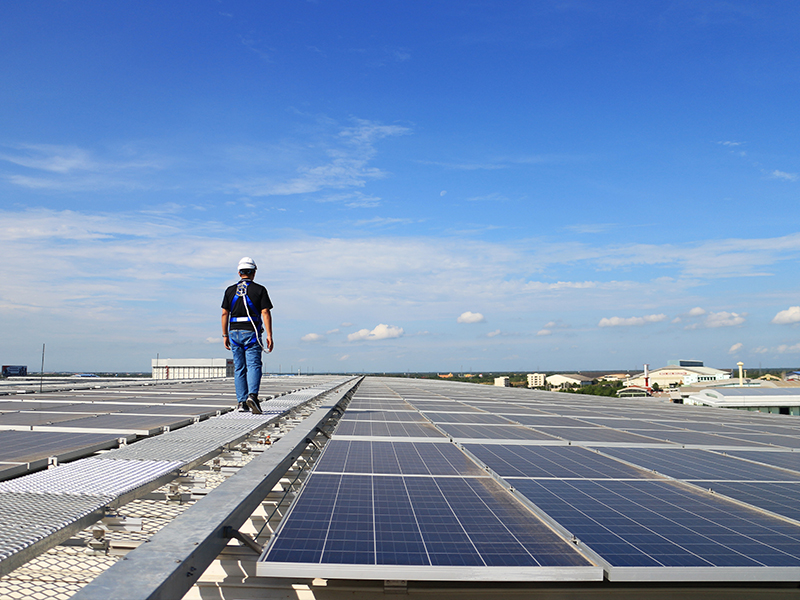These days it seems that Washington, D.C. has a week for everything, so it seemed odd that until last year there was no clean energy week. Well, it’s 2018 and we are nearing the end of the 2nd annual National Clean Energy Week—a week dedicated to America’s clean energy renaissance that is creating jobs, strengthening our national security, and saving businesses money, all with the added benefit of decreasing pollution.
Renewable energy accounted for 17% of domestic electricity generation in 2017 compared to 9% just ten years ago. The vast majority of that growth has been from wind and solar, which shows no signs of slowing down in the foreseeable future. Here at DGA, we’re particularly encouraged by the massive growth in corporations buying clean energy. Nearly half of the Fortune 500 (240 companies or 48%, as of 2017) have established public goals for acquiring clean energy to power their own operations and supply chain through public commitments.
America’s largest companies realize that incorporating clean energy into their business models is a commonsense solution that provides cost saving benefits and greater economic stability. And, consistent with their business models, you can guarantee these moves are motivated by profit, not philanthropy. Don’t just take us at our word, though. Check out these quotes from major companies.
“You don’t do these things just because they’re cool. Saving $25 million, that’s cool,” stated John Wescott, Global Manager of the VF Corporation, regarding his company’s switch towards renewable energy. And he is not the only one thinking this way.
John Legere, President and CEO of T-Mobile said that the switch to clean energy is “not just the right thing to do – it’s smart business! We expect to cut T-Mobile’s energy costs by around $100 million in the next 15 years thanks to this move.”
Additionally, renewables promise consistent energy prices. Lynelle Cameron, Vice President of Sustainability at Autodesk stated: “By powering our business with100% renewable electricity we will not only reduce our carbon footprint but give ourselves a competitive advantage as we protect ourselves against future rises in energy costs.”
Renewable energy provides companies price certainty. Since there are no fuel costs, the price of the energy produced remains fixed for the life of the project or power purchasing contact, more commonly known as a PPA. This allows companies to better predict and manage their operating costs as they are less exposed to fluctuations in fuel commodity prices, which leads to more informed financial planning and increases in their bottom line.
Moreover, the nation’s largest eclectic utilities are beginning to answer the call from their largest customers by providing them options to buy renewable energy at a fixed price for a defined term. These purchasing options are more commonly known as “green tariffs.” As of February, 19 green tariffs in 14 states have been proposed or approved, up from zero in 2012, and several more have been introduced or approved since then.
Personally, I believe green tariffs deserve a name that better reflects their intended purpose—utility purchasing options, corporate choice contracts, customer purchase agreements, anything else really. But, branding aside, the rapid expansion of these purchasing options is nearly as impressive as the number of companies buying renewable energy and highlights the growing awareness of this trend among utilities. But again, I’ll let them speak for themselves.
Robert Blue, President and CEO of Dominion Energy’s Power Delivery Group, expressed his company’s understanding of this trend by stating, “Access to clean energy is joining reliability and price as important considerations when businesses decide to locate their operations… [Renewable energy] opens the door to attracting more businesses and more jobs for the communities we serve.” And, Dominion isn’t alone in understanding the importance of renewable energy access to its key customers.
Last year, Adam Kramer, Executive Vice President of Strategy at Switch, had two simple questions for utilities when looking to site his next data center. “Our first question was: Can you get us our power needs? The second question was: Can you get us 100% renewable?”
The response from Dan Malone, Senior Vice President for Energy Resources at Consumers Energy, at the announcement of Consumers’ Green Rider Tariff Program was clear, “This program, another element of our clean and lean focus, demonstrates how we can help large Michigan employers like Switch to act on their commitments to our state’s economic and environmental future.”
It is as simple as that. As renewable energy becomes increasingly cost effective and profitable, corporations are demanding their access to this resource and shaping state economies.
DGA has long helped to lead this shift in the energy markets by working with corporations, utilities, and state policymakers to advocate for greater customer choice for large buyers. For us, it is not a question of if or even when, but how fast we can provide America’s largest business with access to the energy they want in every state in the nation. Learn more about our series of efforts to connect large customers to a new set of state policy campaigns on customer choice.
